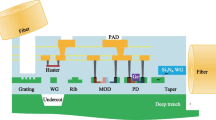Abstract
Wireless networks on chip (WiNoC) are considered to be a novel approach for designing efficient and scalable systems. The rationale behind this new approach is to reduce power consumption and latency in traditional network-on-chip architecture. Indeed, wireless links (WLs) in WiNoC architecture are shortcuts for the fast data transmission between distant cores. However, the presence of wireless equipment in WiNoC architecture leads to an increase in cost and area. In this paper, with respect to the facility location problem, the researchers attempted to optimally allocate wireless routers (WRs) to the processing elements. The methods of simulated annealing (SA), binary genetic algorithm (BGA) and binary particle swarm optimization (BPSO) were used for optimization under different traffic patterns. The results obtained from the simulations of this study indicate that BGA has higher efficiency than SA and BPSO. Furthermore, the resulting structure has fewer WRs, WLs and relatively desirable performance.











Similar content being viewed by others
References
Benini, L., & De Micheli, G. (2002). Network on Chip: A new paradigm for systems on chip design. In Proceedings of design, automation and test in Europe conference and exhibition (pp. 418–419).
ITRS, International Technology Roadmap for Semiconductors. (2007).
Shacham, A., Bergman, K., & Carloni, L. (2008). Photonic networks-on-chip for future generations of chip multiprocessors. IEEE Transactions on Computers, 57(9), 1246–1260.
Chang, M., Cong, J., Kaplan, A., Naik, M., Reinman, G., Socher, E., & Tam, S.-W. (2008). CMP network-on-chip overlaid with multi-band RF-interconnect. In Proceedings of IEEE international symposium high-performance computer architecture (HPCA) (pp. 191–202).
Carloni, L., Pande, P., & Xie, Y. (2009). Network-on-chip in emerging interconnect paradigms: Advantages and challenges. In Proceedings of 3rd ACM/IEEE international symposium network-on-chip (pp. 93–102).
Zhao, D., & Wang, Y. (2008). SD-MAC: design and synthesis of a hardware-efficient collision-free QoS-aware MAC protocol for wireless network-on-chip. IEEE Transactions on Computers, 57(9), 1230–1245.
Hu, W.-H., Wang, C., & Bagherzadeh, N. (2015). Design and analysis of a mesh-based wireless network-on-chip. Journal of Supercomputing, 71(8), 2830–2846.
ARM. ARM11 MPCore. http://www.arm.com
IBM. IBM PowerPC405 Embedded Core. http://www.ibm.com
Wang, C., Hu, W.-H., & Bagherzadeh, N. (2011). A wireless network-on-chip design for multicore platforms. In Proceedings of 19th Euromicro international parallel, distributed and network-based processing (PDP) conference (pp. 409–416).
Wang, C., Hu, W.-H., & Bagherzadeh, N. (2012). A load-balanced congestion-aware wireless network-on-chip design for multicore platforms. Microprocessor and Microsystems, 36(7), 555–570.
Holland, J. (1975). Adaptation in natural and artificial systems. Ann Arbor: University of Michigan Press.
Kennedy, J., & Eberhart, R. (1997). A discrete binary version of the particle swarm algorithm. In Proceedings of the world multiconference on systemics, cybernetics and informatics.
Kirkpatrick, S., Gelatt, C., Jr., Vecchi, M., & McCoy, A. (1983). Optimization by simulated annealing. Science, 220(4598), 671–679.
Pavlidis, V., & Friedman, E. (2006). 3-D topologies for networks-on-chip. In IEEE international SOC conference (pp. 285–288).
Pande, P., Ganguly, A., Chang, K., & Teuscher, C. (2009). Hybrid wireless network on chip: A new paradigm in multi-core design. In 2nd international workshop on network on chip architectures (pp. 71–76).
Deb, S., Ganguly, A., Chang, K., Pande, P., Belzer, B., & Heo, D. (2010). Enhancing performance of network-on-chip architectures with millimeter-wave wireless interconnects. In the 21st IEEE international conference on application-specific systems architectures and processors.
Wang, S., & Jin, T. (2014). Wireless network-on-chip: A survey. Journal of Engineering, 1–7. doi:10.1049/joe.2013.0209.
Kim, K., & Yoon, H. (2000). On-chip wireless interconnection with integrated antennas. In Electron devices meeting (pp. 485–488).
Floyd, B., & Hung, C.-M. (2002). Intra-chip wireless interconnect for clock distribution implemented with integrated antennas, receivers, and transmitters. IEEE Journal of Solid-State Circuits, 37(5), 543–552.
Zhao, D., Wang, Y., Li, J., & Kikkawa, T. (2011). Design of multi-channel wireless NOC to improve on-chip communication capacity. In Fifth ACM/IEEE international symposium on network-on-chip (pp. 177–184).
Tomassini, M., Giacobini, M., & Darabos, C. (2005). Evolution and dynamics of small-world cellular automata. Complex Systems, 15(4), 261–284.
Bahrami, B., Jamali, M. A. J., & Saeidi, S. (2016). Proposing an optimal structure for the architecture of wireless networks on chip. Telecommunication Systems, 62(1), 199–214.
Korte, B., & Vygen, J. (2008). Combinatorial optimization: Theory and algorithms (4th ed.). Berlin: Springer.
Lefebvre, O., Michelot, C., & Plastria, F. (1990). Geometric interpretation of the optimality conditions in multifacility location and applications. Journal of Optimization Theory and Applications, 65(1), 85–101.
Fernandes, L. M., Judice, J. J., Sherali, H. D., & Antunes, A. P. (2011). Siting and sizing of facilities under probabilistic demands. Journal of Optimization Theory and Applications, 149(2), 420–440.
Dally, W., & Towles, B. (2003). Principles and practices of interconnection networks (1st ed.). San Francisco: Morgan Kaufmann.
Parhami, B. (2002). Introduction to parallel processing algorithms and architectures. New York: Kluwer Academic Publishers.
El-Rewini, H., & Abd-El-Barr, M. (2005). Advanced computer architecture and parallel processing. New Jersey: Wiley.
Rao, P. C. S., & Banka, H. (2016). Novel chemical reaction optimization based unequal clustering and routing algorithms for wireless sensor networks. Wireless Networks. doi:10.1007/s11276-015-1148-0.
Kennedy, J., Eberhart, R. (1995). A new optimizer using particle swarm theory. In Proceedings of the sixth international symposium on micromachine and human science.
Soteriou, V., Eisley, N., Wang, H., Li, B., & Peh, L.-S. (2006). Polaris: A system-level roadmap for on-chip interconnection networks. In International conference on computer design (pp. 134–141).
Author information
Authors and Affiliations
Corresponding author
Rights and permissions
About this article
Cite this article
Bahrami, B., Jabraeil Jamali, M. & Saeidi, S. A Demand-Based Structure for the Architecture of Wireless Networks on Chip. Wireless Pers Commun 96, 455–473 (2017). https://doi.org/10.1007/s11277-017-4179-2
Published:
Issue Date:
DOI: https://doi.org/10.1007/s11277-017-4179-2




